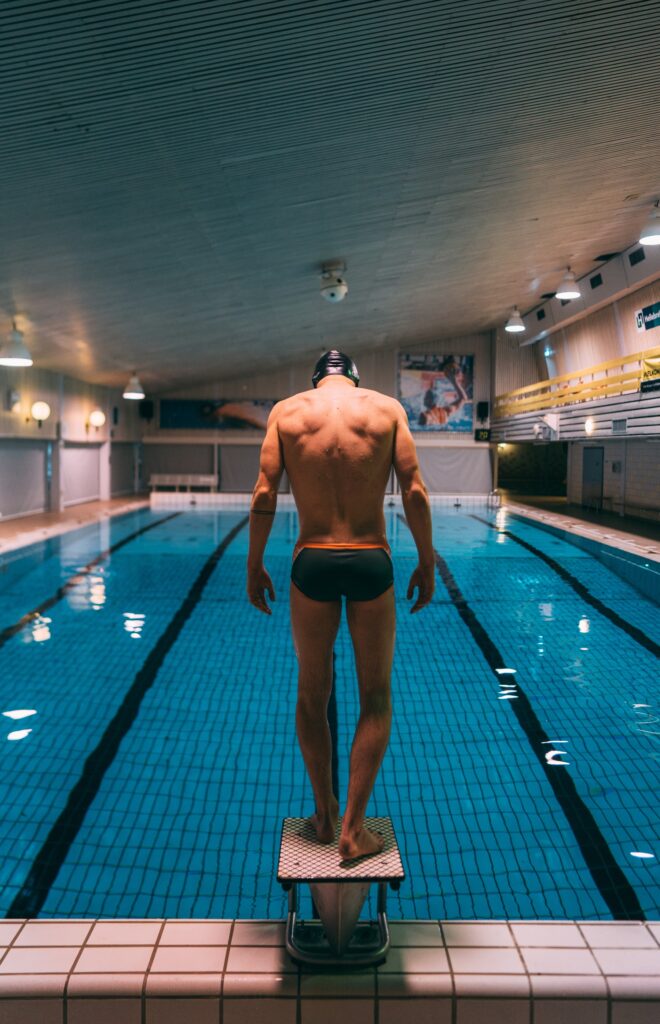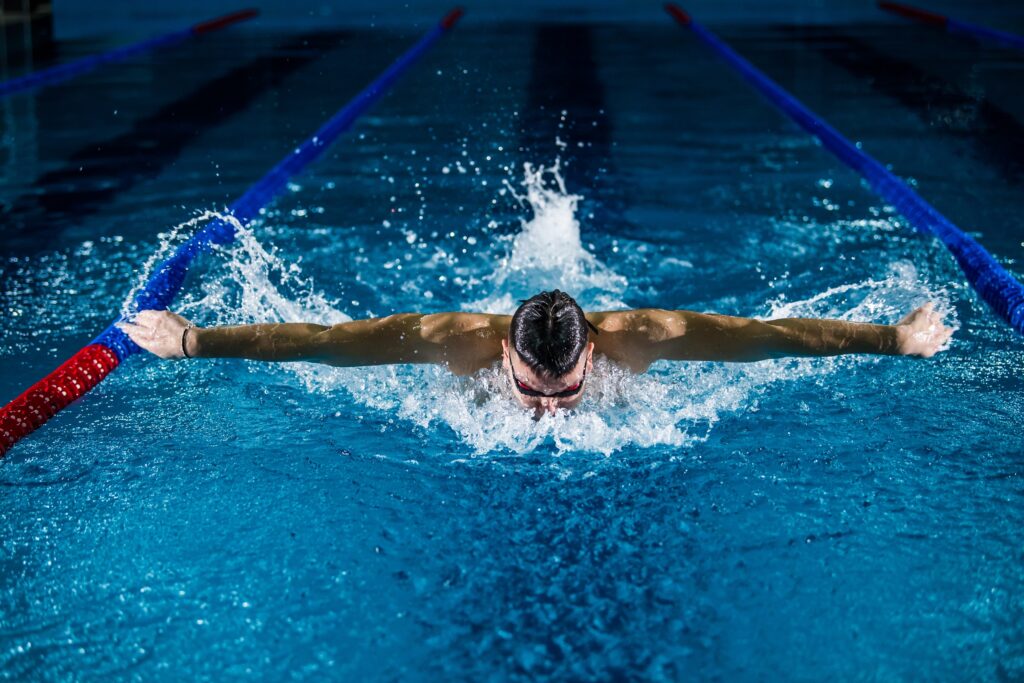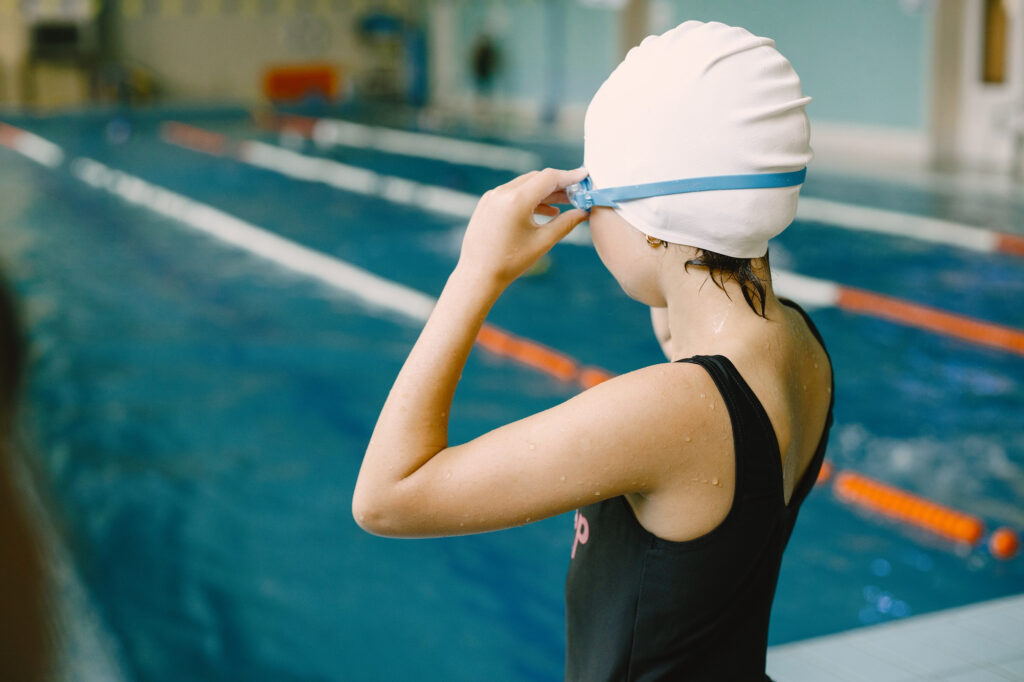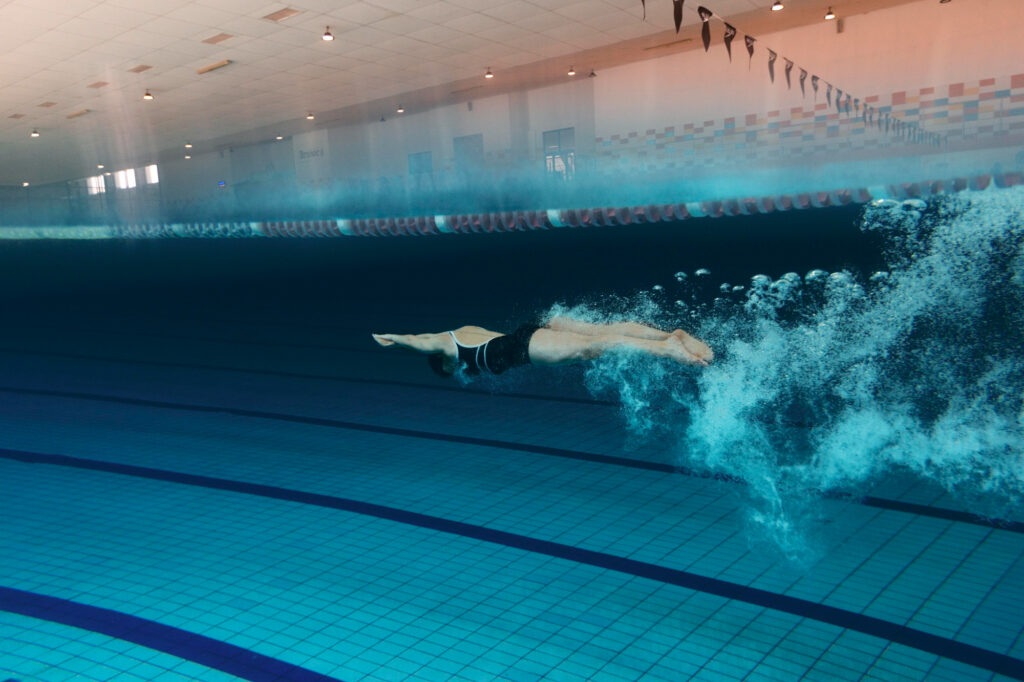Swimming is one of the most demanding yet healthiest sports for body development. It is a recreational activity that remarkably impacts a person’s health.

Swimming accelerates aerobic physical activity while simultaneously strengthening all muscles in the body.
The water resistance, which is 10 to 15 times greater than air resistance, further enhances the effect of swimming on muscle strengthening (similar to exercising with weights). Swimming strengthens the cardiovascular system, regulates blood pressure, deepens breathing, increases lung capacity, and improves tissue oxygenation. Additionally, it has a positive impact on joints, increasing their mobility and elasticity, and enhances movement coordination.
Recreational swimming relaxes the body, reduces anxiety and stress levels, and tones the entire body musculature.
In this way, a significant amount of calories is also burned: 60 minutes of freestyle swimming burns 500 to 700 calories; breaststroke burns 750 calories, butterfly stroke burns 800 calories, while 60 minutes of backstroke swimming burns 500 calories.
For the best effect, daily swimming for 30 minutes is recommended. If that’s not possible, you can still achieve excellent results by swimming three times a week for the same duration.
If there are no health barriers, it’s best to combine all swimming styles as it achieves the best overall effect and evenly develops all muscles in the body. If your goal is to develop your shoulders, chest, and legs, butterfly stroke is recommended. This style, which involves synchronizing breathing and movement, is the most challenging.
HEALTH
Freestyle is the most commonly practiced swimming style. If you swim at a fast pace, this is the style recommended for achieving aerobic effects. Breaststroke is a slower swimming technique that requires stronger legs and shoulders. If you have issues with your neck vertebrae, it’s essential to be cautious, and backstroke swimming is the best option. This style is recommended for those with back problems, poor posture, or deformities.
If you plan to start swimming, there are some essential things to consider. It’s crucial that the water is not too cold, especially if you have acute inflammation of muscles, joints, or a damaged nerve. Pool water is treated with chlorine, so people with certain health issues (sensitive skin, allergies) should be cautious. Avoid swimming right after a heavy meal, but also don’t swim on an empty stomach, as it may lead to a decrease in blood sugar levels. People with epilepsy, especially if it’s not well-controlled with therapy, should be extra careful, and ideally have someone nearby. Those with poorly regulated diabetes should also take precautions.

During the summer, swimming in the sea is recommended due to the numerous positive effects of seawater on people’s health. Do not enter cold water suddenly, as it may cause constriction of blood vessels and cardiovascular problems for individuals with conditions related to blood vessels and the heart.
Research shows that swimming with low intensity has a positive effect on high blood pressure. Easy swimming 4 to 5 times a week for 20 minutes or 3 times a week for 30 minutes is recommended for people with high blood pressure. At the beginning, swim short distances with longer breaks and gradually reduce the breaks and increase the swimming distance over time.
A large number of people, especially young ones, have issues with low blood pressure. While low blood pressure is not as dangerous to health as high blood pressure, it can cause discomfort. Regular and gentle swimming will strengthen blood vessels, and deep breathing will provide additional oxygen to all cells in the body.
Daily sitting can cause numerous problems with the spine. Some issues are related to poor posture, while others are due to defined deformations of the spine. Nowadays, almost 90% of the population experiences back pain in acute or chronic form. Swimming with a backstroke is recommended for a healthy spine, while breaststroke and butterfly strokes are not recommended due to the many movements in certain parts of the spine and the position of the head and neck vertebrae when swimming breaststroke.
PREGNANCY
Swimming is an excellent choice of physical activity for pregnant women. The water reduces gravitational force and protects from injuries, while the hydrostatic pressure of the water pushes blood from the tissue into venous circulation. Moderate physical activity during pregnancy is beneficial as it can alleviate various discomforts associated with pregnancy: it reduces stress, helps prevent gestational diabetes, and reduces the feeling of heaviness in the legs.
CHILDREN

Swimming has a positive impact on the psycho-physical and social development of children because, like other sports, it involves social interactions and socializing. Water is ideal for children as it allows freedom of movement and a sense of lightness, which is crucial for them. Additionally, it develops basic motor skills and contributes to the development of cognitive abilities. Considering that children are constantly growing and developing, swimming is even more important for them. Swimming particularly strengthens the respiratory and cardiovascular systems, develops a sense of movement coordination and self-control. Moreover, swimming has a positive effect on sleep and sleeping patterns, thermoregulation, and immunity.
SENIORS
Recreational swimming is recommended for older adults because they may have specific limitations with other forms of exercise, while swimming has no particular contraindications and can be practiced well into old age. Swimming strengthens the heart muscle and deepens breathing, providing more oxygen to the cells in the body, which is crucial for seniors. There is no joint impact, and swimming elevates mood, reducing depression and difficulties that are common in old age.
WEIGHT LOSS

For individuals with a body mass index (BMI) higher than 25 or 30, swimming is an ideal choice for weight reduction. Unlike other sports with significant joint impact, swimming makes the body seem weightless, reducing stress on the joints. Due to the density and resistance of water, a considerable amount of energy is burned during swimming. Additionally, overweight individuals find it easier to move in water since fat tissue is lighter than bone and muscle tissue. For weight reduction, easy swimming with breaststroke style for at least 20 to 45 minutes, at least three times a week, or freestyle is recommended. After mastering these steps, crawl or backstroke swimming is recommended.
